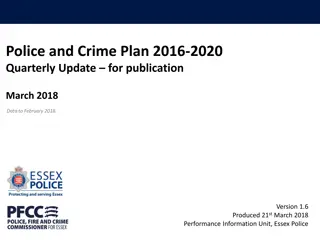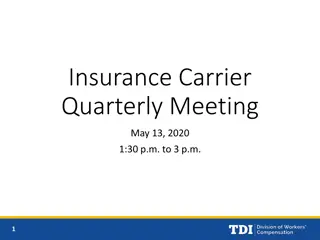Technology Services Board Quarterly Meeting Highlights - December 8, 2020
The Technology Services Board Quarterly Meeting held on December 8, 2020 covered various key topics including updates on the State IT Strategic Plan, Enterprise Architecture Program, and discussions on important elements like big data/analytics and privacy safeguards. The meeting also featured welcome/introductions and insights on the new WA Notify app.
Download Presentation

Please find below an Image/Link to download the presentation.
The content on the website is provided AS IS for your information and personal use only. It may not be sold, licensed, or shared on other websites without obtaining consent from the author.If you encounter any issues during the download, it is possible that the publisher has removed the file from their server.
You are allowed to download the files provided on this website for personal or commercial use, subject to the condition that they are used lawfully. All files are the property of their respective owners.
The content on the website is provided AS IS for your information and personal use only. It may not be sold, licensed, or shared on other websites without obtaining consent from the author.
E N D
Presentation Transcript
Technology Services Board Quarterly Meeting December 8, 2020
Agenda TOPIC LEAD PURPOSE TIME Welcome and Introductions Jim Weaver Introductions 9:00 Approve Minutes from Sept 8 Meeting Jim Weaver Approval 9:04 State IT Strategic Plan Update Sue Langen Strategy Update 9:05 Enterprise Architecture Program Sue Langen Dan Mercer Alignment with Strategy 9:35 Public Comment 10:05 Executive Session for Members and Select Staff Only Closed to public Jim Weaver 10:06 2
Current TSB Members Industry Members Butch Leonardson Retired CIO Paul Moulton Costco Legislative Members Rep. Matt Boehnke House R Rep. Zack Hudgins - House D Sen. Patty Kuderer Senate D Sen. Ann Rivers Senate R Executive Branch (Agency Directors) Jim Weaver State CIO & Chair David Danner UTC Tracy Guerin DRS Vikki Smith DOR Other Government Viggo Forde Snohomish County Members present Members absent 3
Do you know about the new WA Notify app? Go to WANotify.org for more information 4
Welcome/Introductions Approve 09/08/2020 Minutes 5
State IT Strategic Plan Update Sue Langen, Deputy Director for Strategy & Management
Inputs to Plan Governor Priorities CIO Priorities TSB as advisor Input from Agencies Enterprise Technology Strategic Plan 7
Whats Different from Current Plan? 2017 2021 Plan No changes from 2017 Goals 2017 2021 Plan 2021 Plan Minor changes Objectives Priority Initiatives New! Measures Pending 8
Discussion Missing elements? What about big data/analytics? Overall privacy safeguards for data/exchange of data Change framing? Reference specific initiatives or frame around desired outcomes? Technology or business trends to anticipate? Post-COVID Other? 9
OCIO Enterprise Architecture (EA) Program Dan Mercer, State Chief Architect
Agenda 1. Overview 2. Challenges and Opportunities 3. Solution: EA Program Reform 4. Implementation Plan 5. Summary 6. Discussion 11
Overview: What is Enterprise Architecture (EA)? RCW 43.105.20 (5) (EA) is an ongoing activity for translating business vision and strategy into effective enterprise change (EA) creates, communicates, and improves the key principles and models that describe the enterprise's future state and enable its evolution. 12
Overview: Biggest Drivers for Enterprise Architecture Business / Technology Impact Analysis Understanding impact of change before the change happens Application Portfolio Rationalization Reducing wasteful duplication, saving money, improving efficiency Roadmaps for Digital Transformation Planning how new technologies and innovations will enable the digital transformation of government services Business Capability Management Improving business efficiencies and enabling new capabilities Aligning IT investments with enterprise strategies to ensure the right projects are moving forward Business Strategy Modeling Conceptual and Logical Data Modeling Aligning information assets with business strategies, identifying unnecessary duplication and ensuring secure access and privacy Integration Architecture Breaking down data silos - ensuring data flows across the enterprise 13
Overview: Statutory Mandate for EA RCW 43.105.205 and RCW 43.105.265 require the OCIO to lead and implement an ongoing enterprise architecture program for state government with the mission to: Appendix C: RCW 43.105.205 OCIO Created with EA Functions 1.Improve Efficiency a) Drive opportunities for greater enterprise efficiency; 2.Manage Change b) Be the organizing standard for statewide IT; Appendix D: RCW 43.105.265 Defines Use of EA 3.Reduce Risk c) Promote effective enterprise change; and d) Improve the reliability, interoperability, and sustainability of common business processes. 14
Challenges and Opportunities The OCIO s EA program has been an area of underinvestment, generally serving an advisory role. Most statutory requirements and benefits remain unmet. Today the state does not have robust capabilities in areas such as: Statewide EA management framework, models, standards and governance to communicate the enterprise s future state and enable its evolution Enterprise-based strategy - Criteria and roadmap for creation of enterprise services and the basis for business/technology impact analysis Portfolio rationalization Identifying the most strategic opportunities for modernization and reduction of duplicate systems applications Architectural oversight of major initiatives to ensure solutions are aligned with enterprise strategy and architectural standards Enterprise data management and integration architecture to ensure secure data flow throughout the enterprise EA data analysis and reporting capabilities to educate and inform policymakers and strengthen decision-making Appendix A: EA Program Primary Duties Required by RCW 15
Solution: OCIO EA Program Reform Develop Statewide Enterprise Architecture Contract expertise to jumpstart process development Develop enterprise framework, models and standards Meet statutory requirements Be the organizing standard for statewide IT Focus on agility just enough, process just in time EA Tooling Statewide data repository, analysis tools, and web portal Portfolio rationalization capabilities Portal available to agencies architects and decision-makers EA Staffing and Expertise Go from 3 EA positions to 9 over the next two-three years Dedicated solution architects to major enterprise programs, like One Washington Train staff in EA discipline 16
EA Team Focus: FY2021-FY2023 More than 100 major initiatives to monitor, advise and oversee at any given time Source: Adapted from Gartner 17
Implementation Plan Purchase and implement EA tool (in progress) Contractor to develop EA processes and train staff (FY21) Begin hiring additional Enterprise Architects over next three years (Planning) Train EA and Portfolio Management staff on new EA tool and processes Train agencies architects on new EA tool and processes 18
Summary Investing in Enterprise Architecture will enable the OCIO to meet statutory obligations, help the state achieve efficiencies, effectively manage enterprise change, and reduce risk. Short term goals include: Deploy a purpose-built EA tool for OCIO, define data repository, upload data, define relationships, configure decision portal Contract EA expert- Define and document the EA framework, models and processes Define new EA positions begin process of hiring and training new EAs. Appendix B: Federal EA Framework and Tool Demo Begin to improve the reliability, interoperability, and sustainability of IT investments by focused oversight of solution architectures for major projects and strategic initiatives including One Washington and the HHS Coalition. 19
Summary Longer term, Enterprise Architecture will help the state: Look across all agencies and make decisions based on outcomes rather than good intentions; Reverse the trend towards increased technical debt; Strategically prioritize modernization efforts; Identify common business functions that can be satisfied with a shared IT solution instead of buying the same solution multiple times; Break down data silos, strategically integrate and ensure data flows securely across the enterprise; and Squeeze maximum value from every IT dollar. 20
OCIO Enterprise Architecture (EA) Program Thank You 21
Executive Session for Board Members and Select Staff Only 23























